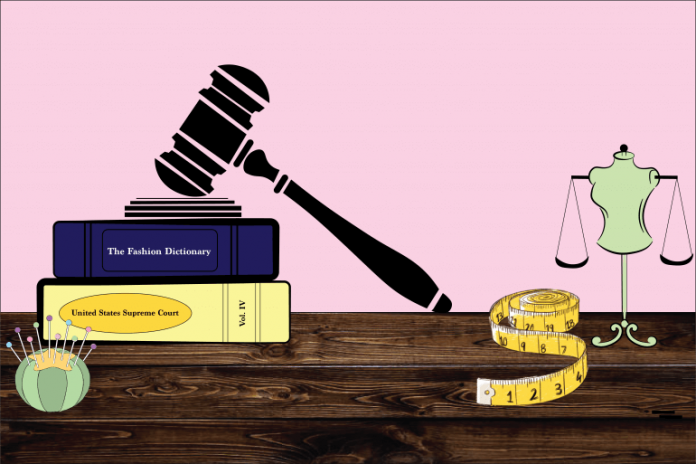This article is written by Chintapalli Leela Madhuri who is pursuing a Diploma in Intellectual Property, Media and Entertainment Laws from lawSikho.com.
Table of Contents
Introduction
Fashion is a social phenomenon. Most people in the world at present wear what can be defined as “world fashion,” a basic and very low-cost variety of Western wear, often a T-shirt with pants or skirts, manufactured on a mass scale. But there are also several smaller and expert fashion industries in many parts of the world that supply regional, traditional, or religious markets.
The fashion industry forms part of a larger social and cultural wonder known as the “fashion system,” a thought that holds not only the business of fashion but also the art and craft of fashion, and not only creation but also consumption.
In the development of intensive growth and modern industrial development trends, recognizing the uniqueness of the fashion industry in each part of the world, focusing on new trends and the needs of target social groups consumers of fashion brands, manufacturers of fashion brands must pay more care to secure their rights.
European Fashion Industries help these fashion designers safeguard their copyrightable works. The most relevant to the fashion industry objects of Intellectual Property are industrial designs, copyrights, and trademarks. This article lights out about European Fashion Industries and the differences and similarities of trademark and industrial designs.
What is meant by the shape, size, and Trademark in the European Fashion Industry?
Europe is a strong, endlessly growing clothing market, home to some of the world’s biggest and most renowned clothing companies and fashion markets. The European clothing industry plays a very important role as an ambassador of cultural heritage and creativity around the world. Although the industry is mostly connected with the fashion sector, the production covers such products as leather clothes, fur, woollen, and crocheted apparel, but also workwear and protective clothing.
The industry is driven by fast-paced innovation alive in the creation of seasonal collections of new fashion designs. Europe remains the midpoint of fashionable clothes, and the protection of fashion designs is a core feature of its cultural identity and legal rules. The European Union Order coordinated national design protection rules across all EU Member States by requiring them to protect “designs” by registration and to define design as the appearance of the whole or a part of a product resulting from the features of the lines, outlines, colours, shape, texture or its ornamentation.
To receive protection, the design must be “original” and have “individual character.” In this situation, original means that there are no identical designs already available to the public. After accepting the EU Order, which already provided rights for registered designs, the European Union enacted EU Regulation 6/2002, which executed a new, unique design right covering unregistered designs in the EU.
The EU Regulation resulted in two types of EU design rights known as registered Community designs (RCDs) and unregistered Community designs (UCDs). Registered and unregistered Community designs are afforded different rights in the EU. EU designers may also be able to depend on national copyright laws to protect designs that meet the conditions under which such protection is consulted, including the required level of originality.
Europe has always been home to hundreds of leading stores and brands, thousands of talented developing designers, forward-thinking tycoons, researchers and educators, and internationally praised designers.
Explanation about the Trademark and Industrial Design?
Trademark
Trademark law offers a form of safety for the wordmarks and logos appearing on a fashion article if they function to identify the basis of the goods. A business has a competitive advantage of having an exclusive right to use the mark on its product’s packaging, website, banners, and online campaigns with a registered trademark.
Subsequently, designers and fashion houses may defend their things by approving an individual trademark that allows the intense public to know the fashion article’s source.
The lack of protection of unique designs in terms of Intellectual Property is the main issue behind the helplessness of Fashion Designs. As a result, many designers are frequently observed charging for violations of their fashion designs.
In the time being, legal clashes may also arise between luxury brands and mass-market manufacturers, who might try to bring their products visually similar to famous brands and, thus, try to attract more customers. For example, in the case of GUCCI Vs GUESS, GUCCI has filed a suit against the American brand GUESS.
The issue of the clash was the use by the American company, Guess of a logo with the letter “G” and a pattern in the form of rhombs. In 2012, GUCCI won a lawsuit in the United States and sued GUESS designs for $ 4.7 million in damages and claims.
Later GUCCI also filed lawsuits against GUESS in many other countries, where GUCCI was unsuccessful. In 2018, the companies completed their long-lasting quarrel and reached a pact, as both parties had put in uncountable hours and spent untold sums of money over the years. Thus, the active protection of Intellectual Property Rights in the fashion industry is the best way to avoid third parties from benefiting.
Industrial design
An industrial design is a form of intellectual property. An industrial design protects a colour, shape, surface pattern, line, or arrangement of an item that rises or produces imagination and improves the presence of a design, whether it’s two-dimensional or three-dimensional. This includes consumer goods and industrial articles, but also e.g., packaging and graphic symbols. Industrial designs that are well established in the marketplace may attract competition.
Meanwhile, some viewers are concerned that too expansive intellectual property rights may increase prices and decrease the availability of consumer goods. Under current intellectual property laws, industrial designs may be protected through copyright, trade dress, and design patents.
Several forms of intellectual property protection are possibly available to industrial designs. Some observers believe that this is unnecessary and does not effectively protect designers, however, in specific, the incapacity of copyright, trademark, and design patent law to protect industrial designs that have some functional component is often criticized.
Others disagree, believing that there is no fascinating case for expanding intellectual property protection for industrial designs and that doing so would limit competition and the availability of products for consumers. The appearance of the product is seen as the first impression by the people.
In this era of creativity, the presentation and visual appeal of any product are very important. Hence, the ability to design a creative presence is a marketable talent in itself. And also, one must make sure that their design was registered. Because design registration makes business sense when it improves the competitiveness of a business and brings in additional revenue.
What are the differences and similarities between Trademark and Industrial Design?
Well, both design and trademark protect the appealing features of a company logo. However, for a deeper understanding trademark protects the symbol or mark and design protects the outer features of the product like shape, outline, or format. Even though both have differences, they work for the protection of the product as part of Intellectual property.
While an industrial design and a trademark are two different types of intellectual property, each is capable of providing important profitable advantages to its owner. Both types of rights may be available at once for a given form if it meets the legal necessities for protection under the corresponding laws.
To get a design registered, it must be new or original and must not be revealed to the public. Whereas, a Trademark can be registered even if it has been revealed to the public i.e. is already in use by the Owner of the mark.
Trademark registration is granted for 10 years and is a continuous right in case renewed on time. However, design protection is granted for 10-years, which can be renewed only for 5 years. These are the differences and similarities of design and trademark.
Conclusion
With the awareness of the worth of intellectual property in the fashion world, there is an open need to reconsider the choice of safeguards that are available to Fashion designs. One of the major causes for infringement of the trademark or design or copyright is people are not being knowledgeable regarding this. So, at least some people must get minimum awareness of this matter.
Along with the fashion designers should educate themselves on Intellectual Property Rights and should try to discover the best protection available for their Fashion Designs. It is vital to warn people on their rights over their creation as the implementation of these rights shall permit a nation to reach success based on its intellectual property.
Trademarks in the fashion industry are quite often rejected on absolute grounds, such as the misleading character of the applied mark as to the place of manufacture of the applied goods due to the attachment of elements, which represent environmental names of cities and countries, while the candidate is from another country. Since such elements are usually non-protectable, it is recommended to carefully consider their presence in the trademark. Hence, European Fashion Industries is helping the people raise employment and increase the fashion sense according to one’s taste in this modern era.
References:
- Industrial Design Intellectual Property: Everything You Need to Know
- Design law in the European fashion sector
LawSikho has created a telegram group for exchanging legal knowledge, referrals, and various opportunities. You can click on this link and join:
https://t.me/joinchat/J_0YrBa4IBSHdpuTfQO_sA
Follow us on Instagram and subscribe to our YouTube channel for more amazing legal content.
 Serato DJ Crack 2025Serato DJ PRO Crack
Serato DJ Crack 2025Serato DJ PRO Crack









 Allow notifications
Allow notifications



